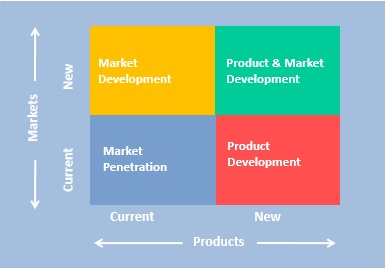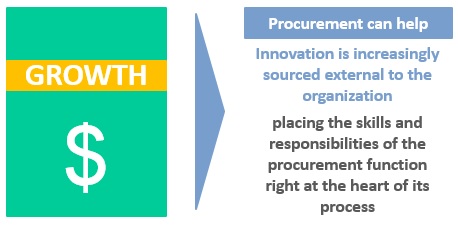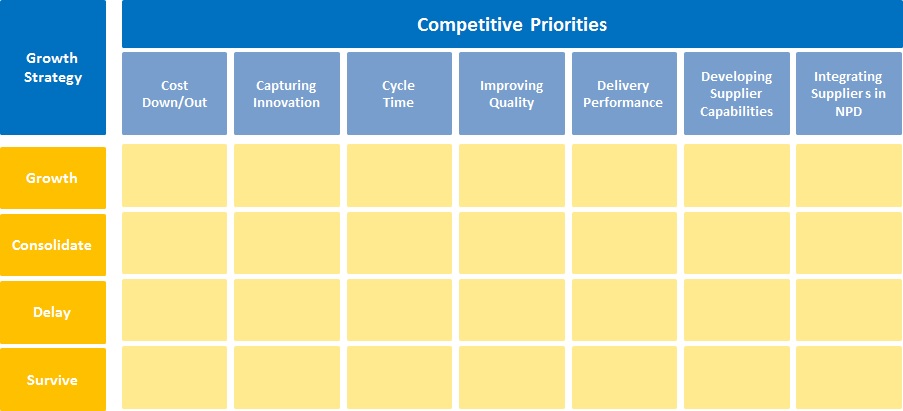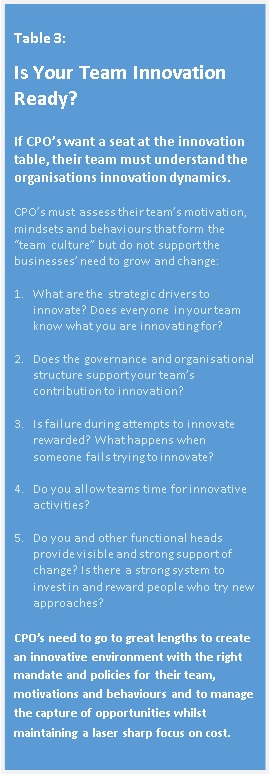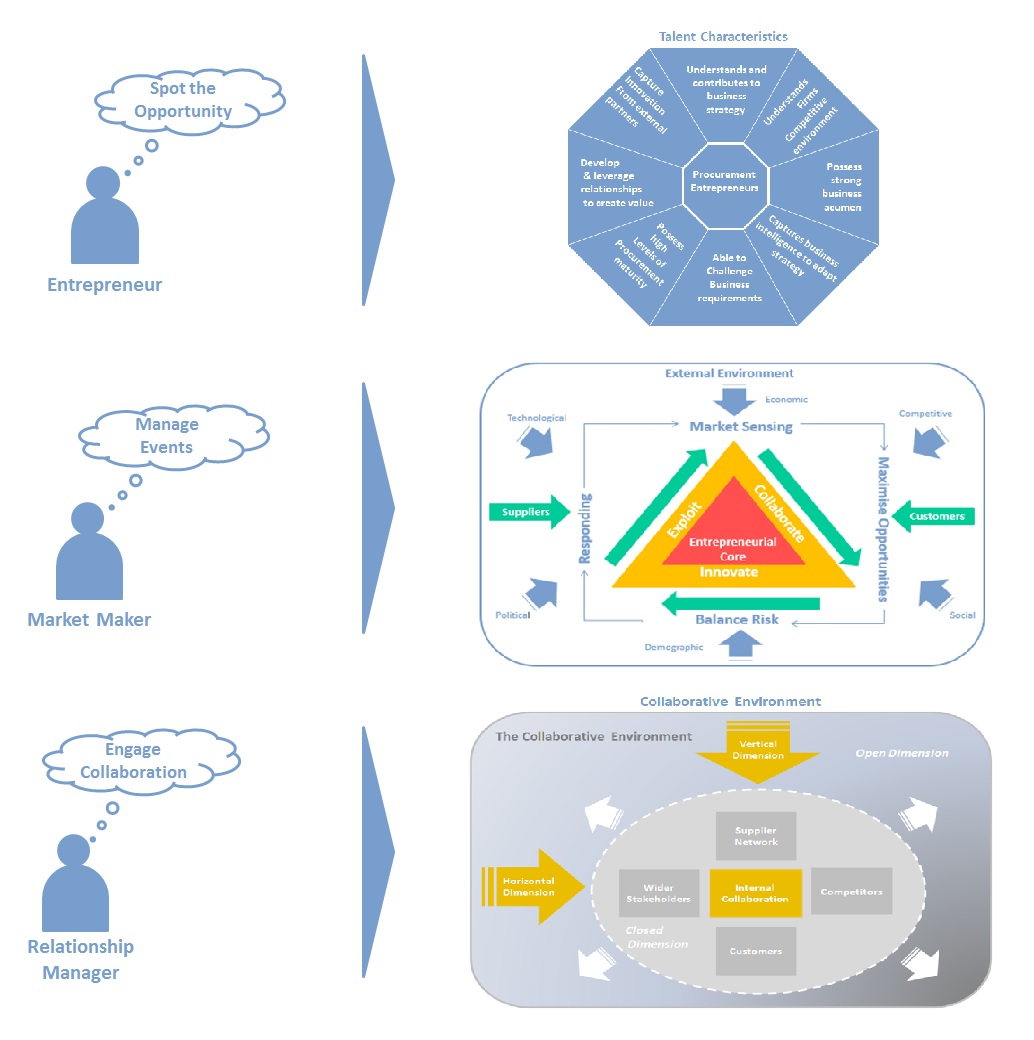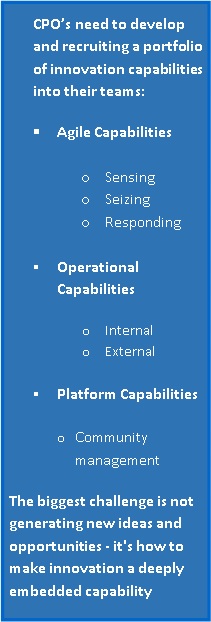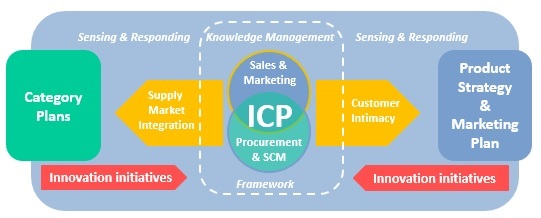The Brave CPO: Leading on Innovation
Innovation Centred Procurement:
We explain how CPO’s can make the connection with the top line.
What’s in it for you?
Increased value from procurement and your suppliers by capturing innovation.
Reading time:
15 minutes
Preface:
Except for a small number of select organisations, the buy side of innovation remains greatly under-exploited which can damage the company’s innovation pipeline.
For the CEO, it can mean lower growth and reduced business performance. For the CPO, it means most are missing the opportunity to connect to the organizations strategic agenda and expand procurements scope and influence beyond cost savings.
By making innovation a component of their procurement transformation journey, CPO’s can make the connection to value via the growth agenda. It requires the careful balancing of successfully managing the ‘here and now’ while simultaneously shaping the strategy and capabilities for the future.
On the one hand, CPO’s must continue to focus on and continuously develop core capabilities such as cost management. On the other hand, they must be strategic and break new ground in order to connect with the broader business agenda to innovate and drive growth. To do this successfully, CPO’s must answer two critical questions on how to insert tangible growth initiatives in the work streams of their teams:
- How to measure and reward executing on the present while building the future, and
- How to align behaviours to specific innovation initiatives that contribute to growth.
CPO’s must be proactive on innovation and generate plans to place procurement at the heart of the innovation process. Unless they do, innovation will continue to occur outside of procurement, and a significant prize is wilfully lost.
Executive Summary:
- CPO’s must engage the business in the innovation “make or buy” decision to determine which parts of the innovation process should be conducted in-house and which should be outsourced?
- Without the necessary skills and capabilities to support innovation, procurement teams cannot be effective.
- By understanding the competitive environment in which their company operates CPO’s can discover the drivers or incentives to innovate for their business.
- CPO’s must understand their organisations growth strategy and its competitive priorities to plan suitable initiatives that successfully connect to the growth agenda. Procurements connections to growth feed its innovation strategy that in turn will drive the innovation initiatives with the most potential.
- Having made the growth connection, CPO’s must provide the answers to questions that lie at the heart of the innovation “make or buy” decision.
- CPO’s must champion innovation centred procurement within the organisation and challenge the organisations performance on innovation.
- If the CPO cannot develop and align a formal procurement innovation strategy with the business then procurement will lack credibility with major stakeholders and suppliers.
- CPO’s must orchestrate procurements integration into the business to effectively manage procurements contribution to innovation. The goal is to secure a receptive internal culture for innovation centred procurement.
- The CPO must demonstrate supply base leadership by focusing suppliers on the company’s strategic objectives which require clear strategic intent.
1. Business Strategy and Innovation:
1.1 Understand Your Company’s Growth Strategy
Any business needs a clearly defined growth strategy to succeed, and the CPO must understand this strategy and how procurement can impact upon it. A growth strategy requires business to decide on:
- Which customers are targeted and which not?
- What products or services shall we offer these customers and what shall we not?
- How will we deliver these services effectively?
When making these decisions, it typically seeks to introduce new products and enter new markets (Fig 1). It can choose to do this either through its existing activities or by entirely new activities or both, whether via a green field initiative, a joint venture, a merger or acquisition.
Procurement must be involved early in the strategy, to evaluate the supply chain and its capabilities. You can’t enter a new market or bring out a new product without a supply chain that can support it. Similarly with M&A, early procurement involvement is critical to capturing synergies to add value.
From the innovation perspective, companies must decide whether to develop products, services or markets themselves or via external sources. CPO’s must, therefore, engage the business in the innovation “make or buy” decision to determine which parts of the innovation process should be conducted in-house and those outsourced?
CPO’s must ensure their teams have the necessary skills and capabilities to support both options.
1.2 Drivers to Innovate
By understanding the competitive environment in which their company operates CPO’s can discover the drivers or incentives to innovate for their business. These drivers include:
- Business drivers; including delivering top line and margin growth, etc
- Market drivers; such as increasing quality and product features to differentiate
- Technology drivers; which can affect the production and distribution of services
- Environmental Drivers; which can impact the product life cycle or brand image.
Each of these innovation drivers is important, and so the CPO should be concerned with and address all of them. However, the organisational strategy will likely favour one or some of them over the others.
1.3 Customer Focal Point
Growth is not about acquiring new technologies or assets; it is about winning an expanded share of existing customers business and winning new customers. It figures then that understanding customers needs and expectations is a key growth success factor. Only by understanding customer needs and their growth plans can new technologies, processes, or assets be applied to deliver growth in your company.
By making customers the focal point for managing growth companies can:
- Ask customers to quantify their growth objectives and put teams in place to help contribute to them
- Create joint growth plans with customers that strengthen each customer’s competitiveness.
- Improve customer retention by helping customers grow
The benefits of this customer-driven approach to growth are:
- Develops a strategic roadmap for future growth
- Creates an actionable plan that identifies tangible key initiatives
- Establish a clear process driven approach to planning
The CPO must ensure that procurement forms a key part of the customer focus team.
2. Procurements Innovation Strategy:
2.1 The firm’s competitive priorities will help shape procurements innovation strategy
When reviewing their organisations growth strategy, CPO’s must consider its competitive priorities. These determine which innovation initiatives will successfully align with the growth agenda. They must also appreciate where their organisation sits in the business cycle; growth, consolidate, delay, or decline.
By understanding these two, factors, CPO’s can prioritise their strategies to support the growth agenda. See Table 1.
2.2 Making the connection to growth:
Procurement can connect to growth beyond freeing up cash via cost savings by:
- Sourcing Innovation
- Cycle time reduction
- Exclusive knowledge capture
- Preferential access to scarce resources
- Increasing SC agility
- Environmental drivers
Such initiatives form the focus for procurements innovation strategy that in turn will drive the innovation initiatives with the most potential.
Table 1:
CPO’s must understand their organisations growth strategy and its competitive priorities to plan suitable initiatives which successfully connect to the growth agenda
Making the Connection to Growth:
Having made the connection to growth, CPO’s must provide the answers to questions that lie at the heart of the innovation “make or buy” decision:
- Will your R&D/marketing departments develop on their own, protecting IP from outsiders? or
- Will they work with suppliers and customers to co-create?
- Should you outsource innovation to your partners to deliver targeted end-results? or
- Should you utilise open innovation to capture innovation beyond the traditional boundaries of the organisation?
Once made, these decisions present further challenges in formulating structures and processes that support innovation sourcing strategy.
Will you:
- Start idea generation or challenges with your entire supply base? Or
- With a few partners? or
- Adopt an open innovation approach
When developing procurements innovation strategy, however, it is important to be very clear about the business drivers behind it. There is no ‘one size fits all’, and considerable challenges await the Brave CPO when tackling these issues.
3. The CPO’s Innovation role:
The CPO is the link between the company’s culture and innovation.
The CPO must be both proactive and opportunistic when implementing Innovation Centred Procurement. They must identify innovation strategies that can increase financial returns for the business and demonstrate procurements value contribution while also acting upon events in the company’s wider environment.
3.1 Proactive Leadership
The CPO must champion Innovation Centred Procurement within the organisation and challenge the organisations performance on innovation.
To succeed the CPO must seek to inspire, enable and facilitate the creation of an innovation mindset within the procurement team and to create a companywide belief in suppliers as powerful allies and not simply cost levers.
Early involvement is a critical objective for the CPO in the innovation process to enable procurement to make a strategic contribution via collaboration with other functions. Indeed, Aberdeen Group reports that best-in-class companies are now collaborating with procurement earlier in the innovation process and making sourcing decisions a higher priority during its early phases.
Last, but not least, a CPO must formalise and align a formal procurement innovation strategy with the business and communicate this openly with major stakeholders and suppliers so that they know the board is behind procurement.
3.2 Leverage Events
CPO’s can take advantage of events in their company’s environment to create momentum and support for change. For example:
- change in senior management
- merger or acquisition
- increase in competitor activity;
- change in technology;
- customer service failure
- change in customer requirements;
Such threats to the business that create new demands for a firm’s products can create the opportunity for CPO’s to get ICP on the agenda.
3.3 Addressing internal capabilities
Most CPO’s will not have the luxury of working in an organisation where procurement already plays a lead role in the innovation process. It will be essential then that the CPO prepares the ground for Innovation Centred Procurement.
Purchasing Practice recommends a disciplined focus on three fundamental areas to lay the foundations for Innovation Centred Procurement. The level of:
1. Organisational capability
Innovation Centred Procurement can only have a positive return on investment when the CPO’s company is innovative itself. So clearly, procurement acting in isolation cannot be fully effective.
CPO’s should, therefore, seek to make Innovation Centred Procurement an organisation wide priority by winning support from senior management. Setting the values and principles, provide insights, and set the rules that drive organisational and individual behaviour.
2. Procurement capability
CPO’s must make an honest assessment of their organisations level of:
- Procurement maturity
- Supplier engagement
- Procurement integration within the organisation
These capabilities are critical to procurements ability to join the innovation agenda.
3. Individual capability
Individual capabilities must go well beyond the traditional toolbox of category and supplier management. Innovation centred procurement requires employees to be able to collaborate, not just in internal teams, but across functions, across country boundaries and with suppliers, customers, and even competitors. CPO’s, therefore, need employees having a more outward-looking mindset that understands the competitive environment of their marketplace.
The ability to look outside the organisation to identify opportunities and risk and to balance these through targeted initiatives are the trademarks of entrepreneurs.
Key characteristics include:
- Business Analyst
- Value Creator
- Sales and profit enhancer
- Customer – market expert
- Goal/achievement orientated
- Desire for autonomy
Entrepreneurial characteristics are important to foster innovation. See also Table 3.
Table 4:
Procurements Future Innovation Roles:
CPO’s must develop entrepreneurial capabilities within their teams to drive the innovation agenda
ICP Capabilities
4. Procurement Integration and Innovation:
Leaders excel at procurement because they are integrated with the business.
Having gained a thorough understanding of the business strategy CPO’s must address structure to support innovation centred procurement. The objective is to orchestrate procurements integration into the business to effectively manage procurement contribution to innovation. Figure 2.
4.1 Internal Integration
The problem for many CPO’s is that they are not “at the table” when significant innovation decisions are being taken.
Procurement is excluded from the innovation process and usually, becomes involved only when it is necessary to execute the decisions via the procurement transaction. In such an environment, procurements involvement comes far too late to engage the supply market in anything resembling a strategic fashion.
Without a top level mandate, the CPO’s ability to prove procurements strategic importance and impact on innovation performance depends in part on its degree of integration. It forms the daily playbook for most CPO’s who must overcome the “which comes first” dilemma:
The realisation that the key to integration lies in proving procurements strategic value, while other functions will only truly integrate when the benefits resulting from procurements integration is verified.
To overcome this dilemma CPO’s must shift their focus towards supporting deep procurement integration across all business areas, as well as procurements integration in the strategic planning process. Such a shift sits contrary to the current business focus on cost cutting. It, therefore, requires that CPO’s carefully balance between securing incremental improvements, via yet another round of cost reductions with suppliers, and concentrating their teams on achieving better integration in the business.
Real success depends upon the ability of the CPO to gain senior management support at the business planning level. They must help shape the vision, develop the capacity and capability to influence strategy via developing and appraising strategic options.
If the senior management just does not believe in the power of procurement, neither will the other functions. Procurement will fall further behind both other well-integrated functions within its organisation and against best-practice procurement organisations in competing firms”
Best-practice procurement functions in competing firms perform so well because they are tightly integrated and are tightly integrated because their senior management supports procurement and enforces integration.
The CPO must challenge the company’s status quo to achieve integration via internal alignment and collaboration. The goal is to secure a receptive internal culture for innovation centred procurement through:
- Motivation to capture innovation from outside.
- Mandate to add to internal innovation by accessing external innovation capacity.
- The mindset that supports a value proposition for suppliers and your company, while allocating risk and benefits fairly.
CPO’s need to develop internal network’s in the same manner as cross-functional sourcing teams. Their goal is to innovate within a company architecture designed to support corporate objectives.
The challenge for the CPO lies in balancing innovation performance with cost management, where the value of innovation is measured against your competitor’s value proposition. To do this, the CPO must successfully manage the competing pressures of capturing new opportunities while continuing to manage cost rigorously.
4.2 Leveraging external innovation networks
The CPO must also demonstrate supply base leadership by focusing suppliers on the company’s strategic objectives, with clear payoffs and allocation of benefits. The CPO must, therefore, develop an engagement strategy consisting of clear:
- Strategic intent
- Governance -roles, responsibilities, process, including executive sponsorship and leadership team
- Initiative prioritisation process
- Guiding principles for the relationships in the process
When creating a network, it is important to keep a laser sharp view of the company’s strategic drivers to innovate. This strategic intent will determine the criteria for designing the network and then creating structure for engagement.
CPO’s can engage the network on innovation via:
- Supplier days
- Idea pitching
- Sourcing challenges
- Partner collaboration
- Market scanning and innovation scouting
Managing supplier relationships is in itself complicated. Communication and decision-making across organisations can be slow, differing business goals and cultures can pull the relationship in conflicting directions, which can be difficult to manage. These difficulties are magnified significantly when working across multiple partners in a network. CPO’s must, therefore, provide the leadership to build the governance structures and core capabilities required in managing network relationships.
Conclusion:
The shape of procurements future:
Innovation Centred Procurement represents a significant opportunity to the procurement profession and the CPO alike.
The opportunity lies in moving procurement beyond a cost savings focus and towards a value focus. The key to this shift is connecting to the growth agenda via innovation.
Innovation places the skills and responsibilities of the procurement function right at the heart of its process, so by making the connection to innovation CPO’s can also connect to the growth agenda.
Some procurement organisations have further to travel to make this connection, but it is a journey with a rich prize at the end for those CPO’s brave enough to challenge the organisational norms.
The payoff is present at the organisational level and the functional level for procurement. At the organisational level, the CEO can improve their organisations innovation performance by accessing the resources and skills of the external value chain. At the functional level, the CPO can visibly demonstrate procurements ability to access innovation from suppliers and increase their organisations capacity to innovate and drive growth.
To achieve the goal of innovation both the CEO and CPO must align the goals, resources, processes and initiatives of the business to support the growth agenda.
For the CEO, this means demonstrably supporting procurement in creating an environment in which it can succeed in capturing innovation. For the CPO, it means developing the capabilities and skills required to contributing to the growth strategy of the business.
Companies seeking to create an advantage over their competitors from innovation should, therefore, be looking at the challenges and opportunities of driving Innovation Centred Procurement.
At Purchasing Practice, we believe that adopters of Innovation Centred Procurement will secure a key capability in differentiating themselves in an increasingly competitive environment. An environment in which, opportunities and risks are going to be increasingly shaped by innovation.
Nuff said ….


